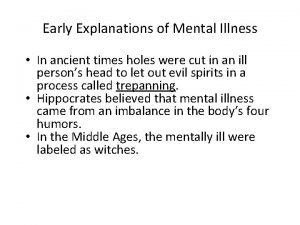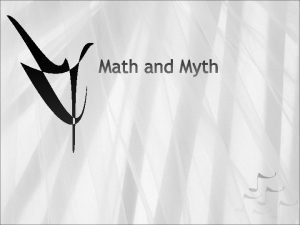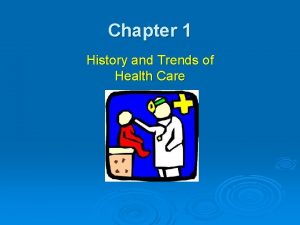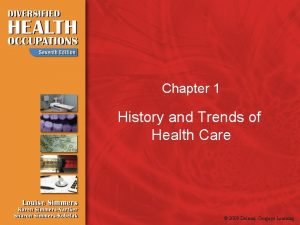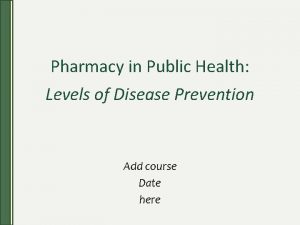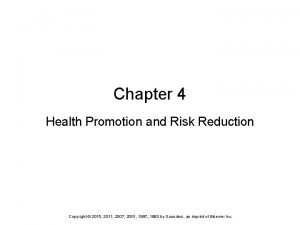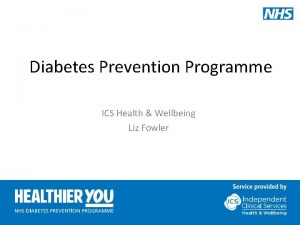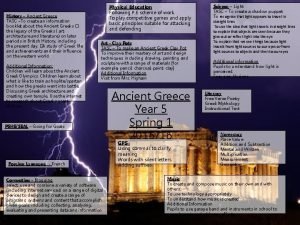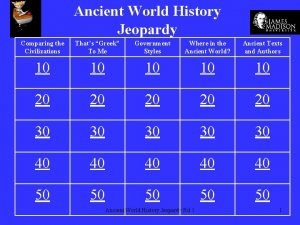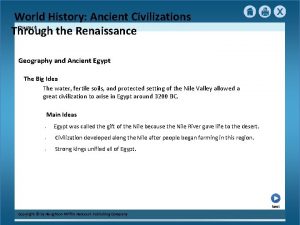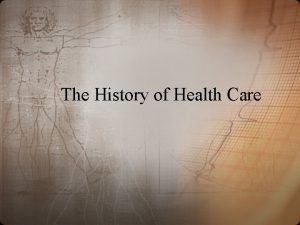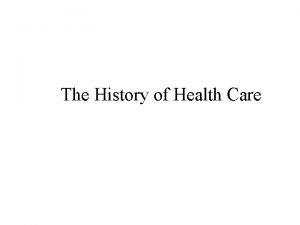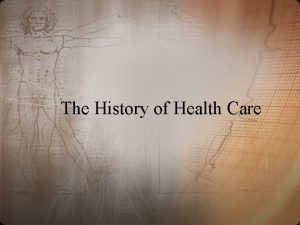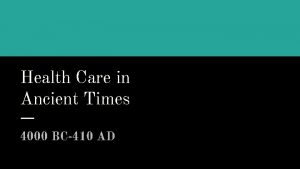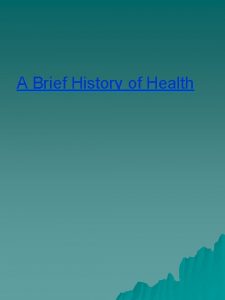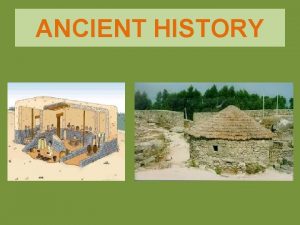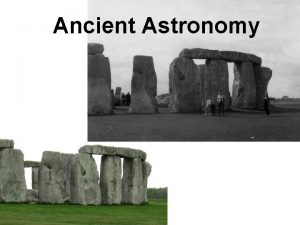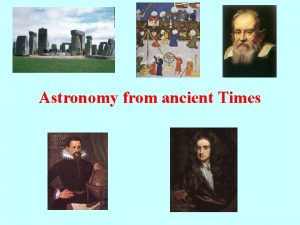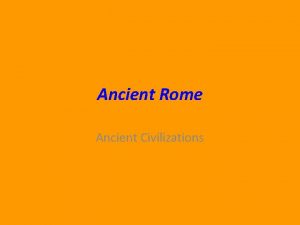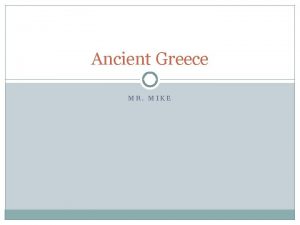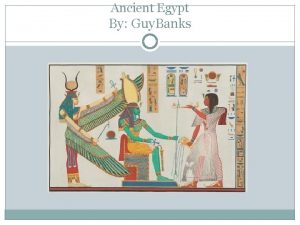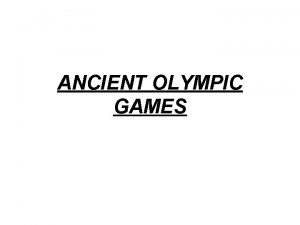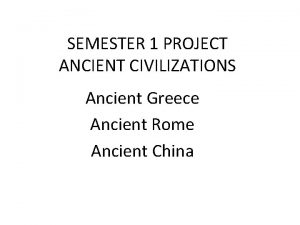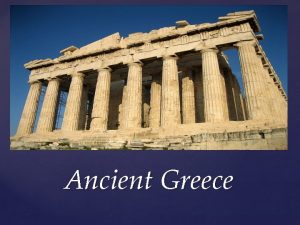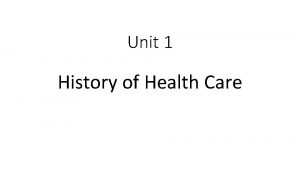The History of Health Care Ancient Times Prevention





































- Slides: 37

The History of Health Care

Ancient Times • Prevention of injury from predators • Illness/disease caused by supernatural spirits

Ancient Times • Herbs and plants were used as medicine examples: – Digitalis from foxglove plants • Then, leaves were chewed to strengthen & slow heart • Now, administered by pills, IV, or injections

Ancient Times • Herbs and plants were used as medicine examples: – Quinine from bark of cinchona tree • Controls fever and muscle spasms • Used to treat malaria

Ancient Times • Herbs and plants were used as medicine examples: – Belladonna and atropine from poisonous nightshade plant • relieves muscle spasms especially GI – Morphine from opium poppy • relieves severe pain

Egyptians • • Earliest to keep accurate health records Superstitious Called upon gods Identified certain diseases • Pharaohs kept many specialists

Egyptians • Priests were the doctors – Temples were places of worship, medical schools, and hospitals – Only the priests could read the medical knowledge from the god Thoth

Egyptians • Magicians were also healers • Believed demons caused disease • Prescriptions were written on papyrus

Egyptians • Embalming – Done by special priests • (NOT the doctor priests) – Advanced the knowledge of anatomy – Strong antiseptics used to prevent decay – Gauze similar to today’s surgical gauze

Egyptians • Research on mummies has revealed the existence of diseases – Arthritis – Kidney stones – Arteriosclerosis

Egyptians • Some medical practices still used today – Enemas – Circumcision (4000 BC) preceded marriage – Closing wounds – Setting fractures

Egyptians • Eye of Horus – 5000 years ago – Magic eye – amulet to guard against disease, suffering, and evil – History: Horus lost vision in attack by Seth; mother (Isis) called on Thoth for help; eye restored – Evolved into modern day Rx sign

Jewish Medicine • Avoided medical practice • Concentrated on health rules concerning food, cleanliness, and quarantine • Moses: pre-Hippocratic medical practice – banned quackery (God was the only physician) – enforced Day of Rest

Greek Medicine • First to study causes of diseases • Research helped eliminate superstitions • Sanitary practices were associated with the spread of disease

Greek Medicine • Hippocrates – no dissection, only observations – took careful notes of signs/symptoms of diseases – disease was not caused by supernatural forces • Father of Medicine – wrote standards of ethics which is the basis for today’s medical ethics – (Invented toothpaste)

Greek Medicine • Aesculapius – staff and serpent symbol of medicine – temples built in his honor because the first true clinics and hospitals

Roman Medicine • Learned from the Greeks and developed a sanitation system – Aqueducts and sewers – Public baths • Beginning of public health

Roman Medicine • First to organize medical care • Army medicine • Room in doctors’ house became first hospital • Public hygiene – flood control – solid construction of homes

Roman Medicine • Aulus Cornelius Celsus is considered one of the most important contributors to medicine and scientific thought during the Roman Empire, and the most important source of present-day knowledge of Alexandrian medicine. Although apparently not a physician himself, Celsus gathered extensive writings from the Greek Empire, translated them into Roman, and compiled their vast knowledge intoan encyclopedia entitled De artibus (A. D. 25 -35). • Considered the 1 st dental surgeon “Keeper of the Teeth”

Dark Ages (400 -800 A. D. ) and Middle Ages (800 -1400 A. D. ) • Medicine practiced only in convents and monasteries • custodial care • life and death in God’s hands

Dark Ages (400 -800 A. D. ) and Middle Ages (800 -1400 A. D. ) • Terrible epidemics – Bubonic plague (Black Death) – Small pox – Diphtheria – Syphilis – Measles – Typhonid fever – Tuberculosis

Dark Ages (400 – 800 A. D. ) and Middle Ages (800 -1400 A. D. ) • Crusaders spread disease • Cities became common • Special officers to deal with sanitary problems • Realization that diseases are contagious • Quarantine laws passed

Renaissance Medicine (1350 -1650 A. D. ) • Universities and medical schools for research • Dissection • Book publishing

th 16 & th 17 • Leonardo da Vinci – anatomy of the body • Anton van Leeuwekhoek (1676) – invented microscope – observed microorganisms Century

th 16 & th 17 Century • William Harvey – circulation of blood • Gabriele Fallopian – discovered fallopian tube • Bartholomew Eustachus – discovered the eustachian tube • Some quackery still going on

th 18 Century • Edward Jenner 1796 – smallpox vaccination • Joseph Priestly – discovered oxygen

th 18 Century • Benjamin Franklin – invented bifocals – found that colds could be passed from person to person • Laennec – invented the stethoscope

th 19 & th 20 Century • Inez Semmelweiss – identified the cause of puerperal fever which led to the importance of hand washing • Louis Pasteur (1860 – 1895) – discovered that microorganisms cause disease (germ theory of communicable disease)

th 19 & th 20 Century • Joseph Lister – first doctor to use antiseptic during surgery • Ernest von Bergman – developed asepsis (sterile) • Robert Koch – Father of Microbiology – identified germ causing TB (tuberculosis)

th 19 & th 20 Century • Wilhelm Roentgen – discovered X-rays • Paul Ehrlick – discovered effect of medicine on disease causing microorganisms • Anesthesia discovered – nitrous oxide, ether, chloroform

th 19 & th 20 Century • Alexander Fleming – discovered penicillin • Jonas Salk – discovered that a killed polio virus would cause immunity to polio • Alfred Sabin – discovered that a live virus provided more effective immunity

1900 to 1945 • Acute infectious diseases (diphtheria, TB, rheumatic fever) • No antibiotics, DDT for mosquitoes, rest for TB, water sanitation to help stop spread of typhoid fever, diphtheria vaccination • Hospitals were places to die • Most doctors were general practitioners

1945 to 1975 • • • Immunization common antibiotic cures safer surgery Transplants increased lifespan chronic degenerative diseases

1945 to 1975 • new health hazards – obesity – neuroses – lung cancer – hypertension • disintegrating families • greatly increasing medical costs

The 21 st Century • Human genome project • Embryonic stem cell research • Threat of bioterrorism with the use biologic agents as weapons • Viruses that can cause pandemic (worldwide) epidemics (continues)

The 21 st Century (continued) • World Health Organization (WHO) is dedicated to monitoring health problems to prevent world wide epidemics • Countries are working together to promote global health awareness

Summary • Health care has seen many changes over the centuries • The future may hold more dramatic ones
 Primary prevention secondary prevention tertiary prevention
Primary prevention secondary prevention tertiary prevention 15 times 15 times 20
15 times 15 times 20 Levels of care primary secondary tertiary
Levels of care primary secondary tertiary Health and social care values unit 2
Health and social care values unit 2 Since ancient times nature
Since ancient times nature Mental illness in ancient times
Mental illness in ancient times Ancient time ancient means of communication pictures
Ancient time ancient means of communication pictures 6 simple machines examples
6 simple machines examples Ever since ancient times
Ever since ancient times I graffiti
I graffiti Since ancient times nature
Since ancient times nature History and trends of health care
History and trends of health care Chapter 1 history and trends of health care
Chapter 1 history and trends of health care Health and social care component 3 health and wellbeing
Health and social care component 3 health and wellbeing Workwell prevention & care
Workwell prevention & care Ancient india vs ancient china
Ancient india vs ancient china Health promotion and levels of disease prevention
Health promotion and levels of disease prevention Health promotion and levels of disease prevention
Health promotion and levels of disease prevention Ics health & wellbeing
Ics health & wellbeing History of theatre ancient rome
History of theatre ancient rome History alive the ancient world chapter 8
History alive the ancient world chapter 8 History alive the ancient world chapter 14
History alive the ancient world chapter 14 Medieval netherlands
Medieval netherlands Tasc ancient history
Tasc ancient history History alive chapter 3
History alive chapter 3 What are the physical features of punjab
What are the physical features of punjab Greek theater history
Greek theater history Ancient egypt kalasiris
Ancient egypt kalasiris Ancient civilizations jeopardy
Ancient civilizations jeopardy World history ancient civilizations through the renaissance
World history ancient civilizations through the renaissance Hình ảnh bộ gõ cơ thể búng tay
Hình ảnh bộ gõ cơ thể búng tay Lp html
Lp html Bổ thể
Bổ thể Tỉ lệ cơ thể trẻ em
Tỉ lệ cơ thể trẻ em Voi kéo gỗ như thế nào
Voi kéo gỗ như thế nào Glasgow thang điểm
Glasgow thang điểm Alleluia hat len nguoi oi
Alleluia hat len nguoi oi Các môn thể thao bắt đầu bằng tiếng nhảy
Các môn thể thao bắt đầu bằng tiếng nhảy





